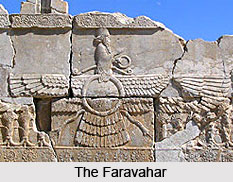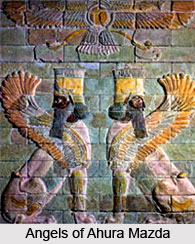 Faravahar, is the symbol of Zoroastrianism. Briefly, it can be said that Faravahar, is the spirit of human being that existed before the person`s birth and will continue to exist after the death. It is important to know that Faravahar, should not be confused with Ahura Mazda.
Faravahar, is the symbol of Zoroastrianism. Briefly, it can be said that Faravahar, is the spirit of human being that existed before the person`s birth and will continue to exist after the death. It is important to know that Faravahar, should not be confused with Ahura Mazda.
Zarathustra says: "O` Mazda, when I was looking for you with my wisdom and speculation faculties and tried to find you with the eye of my heart, I recognized that you are the starter and the end of everything, you are the source of wisdom and reflection and you are the creator of truthfulness and purity and the judge and justice for the behavior of all the human beings."
Due to the fact that in Faravahar`s figure, both "Sepanta Minu," the symbol of goodness and "Ankareh Minu," the symbol of wickedness are carved, they seem to believe that Ahura Mazda and Ankareh Minu are fighting against each other.
The Faravahar`s face resembles the face of human being and therefore, indicates its connection to mankind. There are two wings in two sides of the picture, which have three main feathers. These main feathers indicate three symbols of "good reflection," "good words," and "good deed," which are at the same time the motive of advancement. The lower part of the Faravahar consists of three parts, representing "bad reflection," "bad words," and "bad deed" which causes misery and misfortune for human beings. There are two loops at the two sides of the Faravahar, which represent "Sepanta Minu," and "Ankareh Minu." The former is directed toward the face and the latter is located at the back. This also indicates that we have to proceed toward the good and turn away from bad. There is a circle in the middle of the Faravahar`s trunk. This symbol indicates that our spirit is immortal, having neither a beginning, nor an end. One hand of the Faravahar, points upwards, showing that we have to struggle to thrive. The other hand holds a ring. Some interpreters consider that as the ring of covenant, representing loyalty and faithfulness which is the basis of Zarathustra`s philosophy. In zoroastrianism, the Faravahar or human spirit, embodies two opposing indicators of good and bad.
The Faravahar is a clear indication of Zarathustra`s philosophy that everybody should try to promote his Sepanta Minu (positive force) and suppress his Ankareh Minu (negative force). As a result of such a spiritual struggle toward goodness and avoiding evil, everybody will be able to thrive in all the walks of his life.
Since, the ring of covenant which located in the center of the Faravahar`s trunk is the symbol of the immortality of the spirit, it can be said that more human beings try to promote their own Faravahar, more their spirit will be elevated in the other world after they pass away. For that reason, ancient Iranians would never mourn at the death of their beloved ones, because they would believe that their spirit will be elevated to a higher level in the other world.
Spenta mainyu
Spenta Mainyu is the manifestation and projection of creative will and thought of Ahura Mazda. The two are co-eval and eternal. One is the unmanifest and Spenta Mainyu is its manifest form of Ahura Mazda. Spenta Mainyu represents the good thought, will and creative act of Ahura Mazda.
Ahura Mazda can be worshipped only through Spenta Mainyu who can be said to be the Vicegerent of God. Zarathustra also gives his blessings to his votaries who worship him through Spenta Mainyu. Spenta Mainyu is the creative, sustaining and administering Spirit of the whole universe.
Ahura Mazda`s Angels
Ahura Mazda`s six cardinal virtues of Vohu Manafi (good mind), Asha (righteousness), Khshathra (God`s Kingdom), Arpiaiti (Devotion), Haurvatat (perfection), and Ainerctat (immortality). Soon these abstract and spiritual attributes of Ahura Mazda were personified and they became the holy angels or associates of God. Vohu Manah, Asha and Khshathra are male members in the divine hierarchy, and, Armaiti, Haurvatat and Ameretat are feminine names.
Vohu Manah has been personified into Vohu Mainyu (good spirit). But Vohu Mainyu should not be confused with Spenta Mainyu who is the supreme manifest spirit of Ahura Mazda. Vohu Mainyu furthers the kingdom of God.
 Asha symbolizes nature`s uniform and orderly workings and stands for the moral regeneration of man.
Asha symbolizes nature`s uniform and orderly workings and stands for the moral regeneration of man.
Khshatra signifies God`s might and power. Armaiti symbolizes devotion to Ahura Mazda. Haurvatat (perfection) and Ameretat (immortality) are also personified attributes of Ahura Mazda.
Amongst all the attributes Vohu Manah and Asha are most important. The mighty power of Vohu Manah will become most manifest when all the people will have to pass through the bridge Chinvat. Vohu Manah will come to the aid of the righteous; whereas the evil-doers will be punished. It will be through fire that the righteous will be rewarded and the wicked will be visited by fire with a view to destroy them.
Asha stands for righteousness, which is the centre and soul of the ethical end of Zarathustra. It is the path of righteousness which Zarathustra sought and taught.
Angra Mainyu of Ahriman
Creation means something is destroyed and newer things come into existence. Hence, imperfection is the inevitable result of creation. When Spenta Mainyu tried to create a good world, its counterpart in the form of Ahriman or Angra Mainyu introduced evil in the world. All the problems and calamities like draught, flood, epidemics etc are all for Ahriman and his associates.
From the very beginning, devas have been imagined as evil and in the long run Indra, the war-god of the Indo-Aryans came to be regarded as the arch-devil.
It is also reported that like Lord Buddha and Jesus Christ, the first prophet of Zoroastrianism, namely, Zarathustra was also tempted by the devil called Ahriman. Again, Zarathustra succeeded in defeating the attempts of Ahriman.
Whatever be the account of the dualism of good evil in Zoroastrianism, it is fully religious. Evil is accepted as a fact of life. Whatever the name of evil be given, Ahriman, according to Zoroastrianism, pollutes the whole creation and, lulls the conscience of men and lures their mind, speech and action for the evil. Thus Ahriman creates an evil spirit in man, and, thoroughly distorts his real nature. It is this evil nature in men that has to be purified through prayers and rituals.
It is very tough to fight against evil. Evil is a fact of real life, according to Zarathustra. He advises his followers to become a soldier to fight against the evil. Evil is as much within as without. There is a fight between the evil and the good even in the soul of a man. God Ahura Mazda calls upon man to fight the evil in man and outside of him, against all the evil spirits of Ahriman and Ahriman himself. Hence, this struggle against all kinds of evil in nature and man has been ordained by Ahura Mazda himself. By fighting againt evil man becomes a co-worker and co-sharer of Ahura Mazda himself. Sacrifice makes a man active in the conflict with evil. Sacrifice is more than worship. It is a form of assistance to Gods in their fight with evil.
Evil no doubt is an evil, but it means a challenge for man so that by overcoming evil man may become fit for entering the heaven. As such evil is a necessary test and trial for man. It has been ordained by God so that man may rise higher than even angels. This is a conception which has been taken up in Islam by lqbal. Man has been given free will either to choose evil or good. If he by his free will chooses the good, then he will rise higher than the angels. If not, then he will face hell and its torments.
Zoroastriasm states two things very clearly, namely, the evil within man is a greater challenge than the evil outside of man. As such man can fight the evil through his good thought, good speech and noble deeds. Secondly, it has to be kept in mind that evil is not the final thing. Ultimately Ahriman and all his associates will be defeated and destroyed and a great renovation will be followed in the final reckoning of things. This means that evil is only a temporary phenomenon and goodness alone is the final thing. Thus, the dualism in Zoroastrianism is only relative and Ahura Mazda remains the only Reality. Thus dualism is swallowed up in the Absolute monotheism of Zoroastrianism.




















